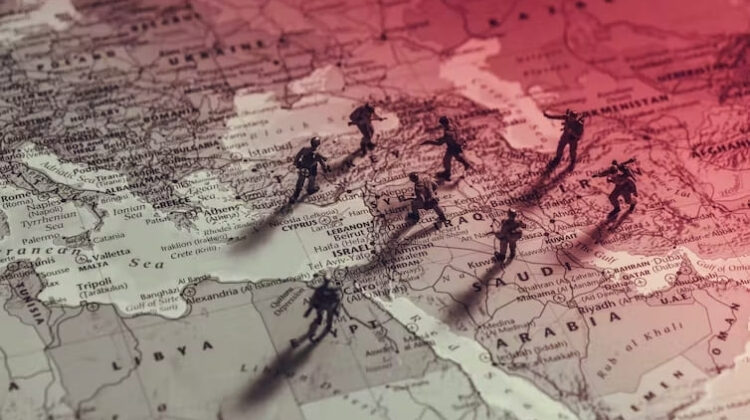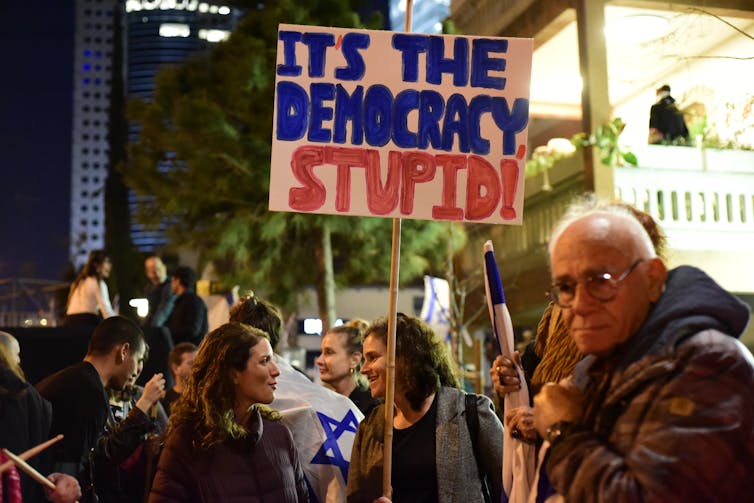
Middle East: recent developments could rewrite the political map – but a lot will depend on Israel
kirill_makarov via Shutterstock
Paul Rogers, University of Bradford
Following political developments in the past fortnight, two state-level policy changes in the Middle East are likely to combine to have a substantial impact on regional stability.
On March 10, in a deal brokered by China and signed in Beijing, Saudi Arabia and Iran agreed to reestablish diplomatic relations and reopen embassies after a seven-year break. While a long way from bringing an end to conflicts such as the bitter war in Yemen, it is, as Simon Mabon noted in an article for the Conversation, a positive development.
The previous week, writing in the Times, Middle East correspondent Michael Spencer revealed a plan by Gulf states to restore relations with the Assad regime in Syria.
If this report is accurate, the implications of the two developments for Middle East politics are substantial – not least because of recent social and political developments in Israel and Iran.
Arab detente
The essence of the Times story was that some Arab states want to normalise relations with Damascus – even if this is opposed by the US and its western allies. This should involve an easing of sanctions and more regional economic integration.
It will also mean getting Syria back into the Arab League, from which it has been suspended since 2012 following its brutal suppression of Arab Spring protesters. The move is championed by the United Arab Emirates (UAE) and along with the Saudi-Iran agreement has the potential to reorder the balance of power in the region.
The early indications are that beneficiaries of the two developments will include China and the individual regional autocracies involved. Beijing will benefit by taking a key role in facilitating the deal, thereby increasing its status across the Islamic Middle East and north Africa.
Russia is also likely to benefit, if less directly. It has carefully nurtured its military connections with Syria over the past decade, starting with its small naval facility at Tartus, which has the potential to give Russia a warm-water Mediterranean port. The port at Tartus is in the middle of a significant expansion that includes the construction of a new floating dock for ship repair.
Russia has also long had the use of the Syrian Air Force’s Hmeimim airbase and has recently extended one of the runways. The base is now something of a military transport hub for links to Libya and states further south across the Sahel. Moscow also maintains close military connections with Iran, a relationship which is currently bearing fruit in the shape of a supply of armed drones for its war in Ukraine.
Nuclear deal
If both China and Russia benefit from the likely changes, what of the one other key state within the region, Israel? The long-term response of the Netanyahu government to the new circumstances will depend greatly on the status of the presently defunct Iranian nuclear deal.
A recent period of tension was eased by quick diplomacy by the head of the UN’s International Atomic Energy Agency (IAEA), Rafael Grossi, last month. There has been subsequent talk of a breakthrough on verification and monitoring activities. For the moment, the possibility of a crisis has lessened but not disappeared.
After years of gradual progress while Barack Obama was in the White House, the 15-year agreement was reached in July 2014 which would limit Iran’s nuclear ambitions in return for sanctions relief. The joint comprehensive plan of action (JCPOA) involved Iran, the US, China, France, Russia, Germany and the UK. The deal came into force in 2015.
It was disliked from the start by an Israeli government deeply suspicious of Iran. Israel’s concerns were subsequently partly assuaged by Donald Trump, who ditched the treaty and strengthened the sanctions regime in 2018. Since then, Iran has considered itself free of the limits but has eroded them round the edges rather than ditching them completely.
The current occupant of the White House, Joe Biden, has so far avoided strident condemnation of Iran’s actions. Not so for Israeli prime minister Benjamin Netanyahu.
But at present the Netanyahu government’s approach is also affected by the deep political and social unrest currently affecting Israel itself. This stems from a combination of a long-term division between the secular and the religious.
Secular Israelis tend to want the country’s judiciary to exercise a degree of power over the Knesset legislative body through the country’s supreme court – not least in matters of human rights.
Jewish religious parties, on the other hand, mostly want those powers subject to higher religious authority exercised through the Knesset. Netanyahu’s majority currently depends on the support of his ultra-religious coalition allies. And here lies the problem.

While Netanyahu’s proposals to limit the power of the judiciary may be popular with his far-right parliamentary colleagues it has aroused fierce opposition, with hundreds of thousands of protesters taking to the streets. What makes them particularly significant is that they extend to the armed forces, with many of Israel’s most experienced air force pilots joining the protests.
Traditionally, suspicions of Tehran are held across the political spectrum in Israel. This is rooted in Israel’s idea of itself as a bastion of western-style liberal democracy in a sea of Islamic autocracy. But now the evolving – and increasingly extreme – religious dimension in Israeli politics takes that to an even stronger level of concern over Iran’s real nuclear intentions.
Israel may have succeeded in strengthening economic links with some oil and gas-rich Gulf States, but it is far from convinced that the Iran/Saudi political thaw will have any effect on Iran’s nuclear intentions.
In that it is probably correct. Tehran has little confidence in the stability of the US’s approach to the JCPOA after what happened under Trump. So, while the developments of the last two weeks may be welcomed by many, on this issue at least, little has changed.
Paul Rogers, Professor of Peace Studies, University of Bradford
This article is republished from The Conversation under a Creative Commons license. Read the original article.
